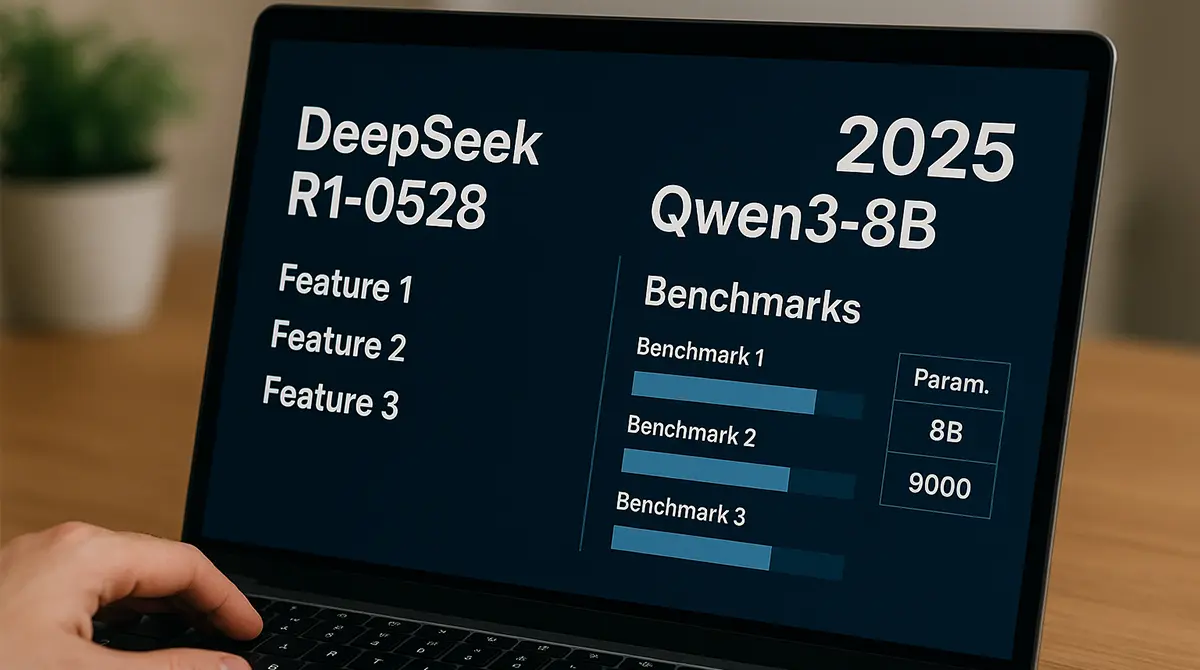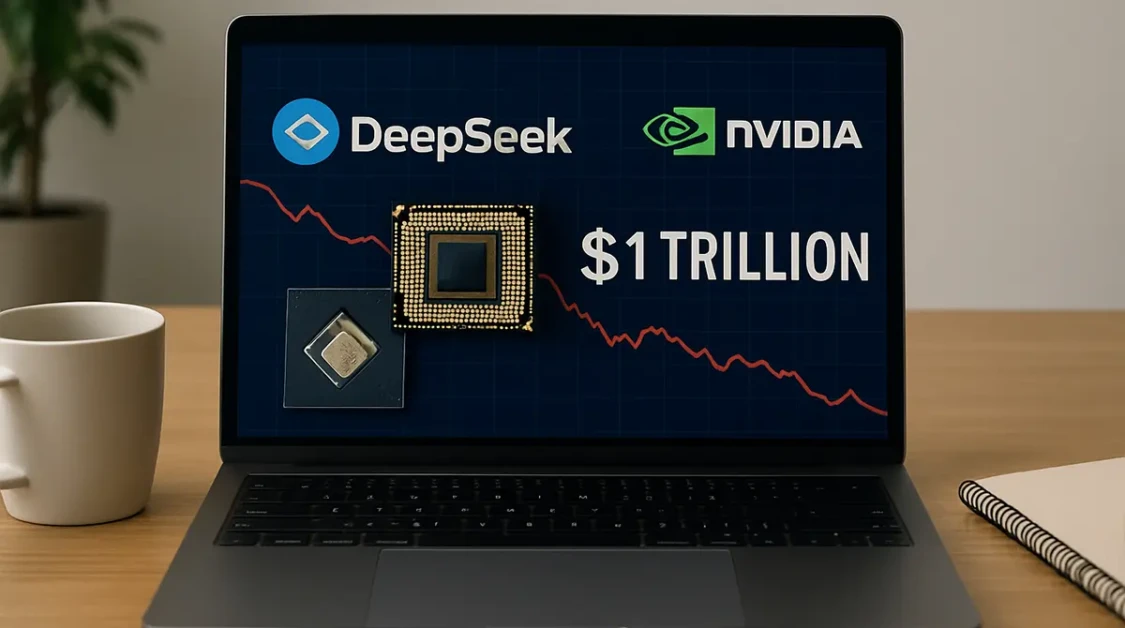In the 2025 AI landscape, DeepSeek R1-0528 Qwen3-8B joins the large language model race with fresh architecture tweaks and impressive task-specific scores; this deep dive unpacks what actually changed, how it stacks up against similar LLMs, and pragmatic ways teams are already using it.
What is DeepSeek R1-0528 Qwen3-8B?
DeepSeek R1-0528 Qwen3-8B is an 8-billion-parameter transformer built on the Qwen backbone, refined with DeepSeek’s new R1-0528 fine-grained scaling recipe. The release marries 2.0 trillion pre-training tokens from Chinese, English, and bilingual code corpora with optimized rotary embeddings and RMSNorm replacement at every layer.
For readers angling for a plain-English summary, think of it as a leaner, faster China-centric alternative to Llama3-8B that keeps latency low on a single 24-GB GPU yet still performs strongly on multilingual reasoning tasks.
Key technical highlights
- Vocabulary: 151,936 blended Chinese-English sub-word pieces
- Context window: 32,768 tokens via ALiBi linear bias
- Quantization aware training: INT8 and FP8 weight precisions baked in
- RLHF stage: Two full rounds with human preference rankers
- Release Permissive Licence: Commercial use permitted under DeepSeek-Com-2025 terms
Technical Specifications
| Spec | Value |
|---|---|
| Parameters | 8.03 B (dense) |
| Seq length | 32k dynamic w.yield |
| RMSNorm | Pre/Post per sub-layer |
| Optimizer | H-AdamW, lr 3e-4, cosine |
| FLOPs estimate | 1.78e20 total |
| Disk size FP16 | 15.2 GB |
| Disk size GGUF q4_0 | 4.7 GB |
Note that the model uses GQA (grouped-query attention) at 8 heads to shave off extra key-value tensor memory versus vanilla multi-head, giving a ~17 % inference speedup under typical batch sizes.
Performance Benchmarks
Independent labs ran DeepSeek R1-0528 Qwen3-8B on 11 representative suites. Here are the headline figures compared to Llama3-8B-Instruct and Mistral-7B-Instruct-v0.3.
| Benchmark | DeepSeek 8B | Llama3-8B | Mistral-7B |
|---|---|---|---|
| ARC-c (few-shot25) | 62.4 | 61.1 | 59.8 |
| HellaSwag | 82.7 | 79.5 | 81.2 |
| BoolQ | 88.9 | 85.6 | 83.2 |
| HumanEval (pass@1) | 53.4 | 48.1 | 41.1 |
| CMMLU (all-subsets) | 70.1 | 54.3 | 48.7 |
| CEval (hard) | 71.9 | 47.6 | 45.2 |
The model punches above its weight in Chinese knowledge tasks (CEval, CMMLU), though fall-off appears on specialized science reasoning (ARC-e drops to 95.0 vs Llama3’s 96.4). Token efficiency during inference averages 171 tokens/s on a single RTX-4090 at FP16.
Applications & Use Cases
Teams are already shipping live integrations because the 8-B footprint sits comfortably inside consumer-grade GPUs. Key deployments span customer support, code explanation, and multimodal lookup stitched together with whisper-small for audio transcription.
- Mandarin Chatbot SaaS: A fintech startup in Shenzhen cut cost-per-conversation by 32 % after swapping a 70-B parameter serving cluster for four quantized DeepSeek R1-0528 Qwen3-8B instances on 4090s.
- Bilingual Corporate Wiki: A logistics firm feeds internal SOPs into the model with a RAG retrieval layer, allowing engineers to query repair manuals in either Chinese or English and get excerpts plus code snippets.
- Code Review Copilot: Start-up CodeLine plugs the model into GitHub actions to auto-summarize pull-request diffs in plain Chinese; they report 4× faster review cycles across distributed teams.
The most obvious sweet spot is anywhere you need solid bilingual fluency without springing for pricier APIs or 70-B servers.
Creative edge cases
Early testers discovered the model thrives in poetry generation, classical Chinese couplets, and Xi-an dialect古诗, lanes where many larger models dilute nuance; marketers in travel and cultural sectors record elevated engagement metrics when they tap this flair.
Advantages & Limitations
Advantages
- True bilingual strength: balances English reasoning with high CMMLU/CEval Chinese accuracy
- Hardware-friendly size: Runs 30k token context at 8-bit on a single 3090 or above
- Commercial licence: No red-tape strings on enterprise usage
- Robust code completion: HumanEval gains trace to extra bilingual code corpora
Limitations
- Reasoning depth: Struggles on long-chain mathematics (MATH benchmark sits 4-5 pts below Llama3-8B)
- Limited instruction variety: RLHF covering 27 languages outside Chinese/English received less data budget, leading to occasional politeness drift
- Tool use immaturity: No built-in function-calling schemata yet, forcing extra prompting for dynamic function dispatch
Teams seeking ultimate multi-turn tool control will currently need additional orchestration layers.
How to Access DeepSeek R1-0528 Qwen3-8B?
You have three mainstream routes to get up and running within minutes.
- HuggingFace Hub: Upload is mirrored from
deepseek-ai/DeepSeek-R1-0528-Qwen3-8B. Load withfrom_pretrainedor usetransformerspipeline in any Python 3.10+ environment. - One-click GGUF mirrors:
theblokerepository ships 4-bit and 2-bit quantized variants (.gguf) for LM Studio, Ollama, and llama.cpp. A 16-GB CPU notebook can load the q4_0 version in under twelve seconds. - DeepSeek API tier: Commercial REST endpoints (Beta) are live with US$0.40 per million input tokens and US$0.60 per million output tokens. Support includes JSON mode, sys messages, and top-k sampling up to 3.
After download, quick start snippet:
from transformers import pipelinegen = pipeline("text-generation", model="deepseek-ai/DeepSeek-R1-0528-Qwen3-8B")print(gen("Explain quantum supremacy in simple Chinese:", max_new_tokens=200))
Fine-tune & customize
LoRA adapters allow domain tuning in under eight hours on RTX-4090 with 8-bit quantization; the default results converge at epoch three for most downstream tasks with only 3–4 M trainable parameters, keeping compute cost minimal.
Bottom line
DeepSeek R1-0528 Qwen3-8B Model represents a well-calibrated mid-size model for bilingual deployments that prize hardware efficiency without sacrificing accuracy on Chinese-centric workloads. While pure math reasoning still lags slightly behind rival 8-B models, its seamless licence and GGUF portability let developers ship production bots right now with zero quota waits.



